
The Gospel of Luke
A Great Banquet: Lk 5,27-39
This passage is marked as a unity by the new beginnings in 5,27 "After this he went out..." and another new beginning in 6,1 "One sabbath ..." The passage unfolds from the call of Levi (5,27-28) to Levi's great banquet (5,29) and then the dispute with the Pharisees (5,30-39). Luke has neatly woven together three originally separate incidents as we saw in the overview.
The call of Levi: 5,27-29
The story opens with the call of Levi, so called also in Mark (Mk 2,14) but called Matthew in that Gospel (Mt 9,9). However, in 6,15 Luke says it is Matthew who is called to be one of the Twelve.
More so than Peter (5,11), Levi would have been a sinner. Like the leper he would have been unclean especially as he would have been handling coins with the emperor's head on them (20,24). (That would have been a form of idolatry as the emperor was given divine status.)
Unlike Peter, Levi received the direct call "Follow me" from Jesus but, as with Peter, we are told that Levi left everything and followed Jesus.
Banquets and meals are important events for Luke, there are a number of them all the way through to the resurrection chapter 24. Hence Luke makes the stress on the great banquet in 5,29 which is not found in Mark.
Reaction of the Pharisees: 5,30-39
This leads into the discussion with the Pharisees and scribes. First there is their immediate reaction (5,30-32). Whereas earlier (5,21), the scribes and Pharisees were questioning themselves (5,21), now they make their complaint to the disciples (5,30), though it is Jesus who answers (5,31).
To Jesus' call to sinners in verse 32, Luke adds "to repentance". This could be a preparation for the continuation of the discussion which will now primarily concern fasting.
The theme of the bridegroom (5,34) has deep roots in the Old Testament as a description of the bond between God and Israel. Hosea 2,16-23 is perhaps the best example though the same theme is found in Isaish 61,10 & 62,5 and elsewhere.
The implication must be that Levi's great banquet is appropriate because Jesus, the new bridegroom, was present.
Luke twice specifically states that Jesus spoke a parable (5,36 & 6,39). The image of old and new is found also in Mark. Jesus must be pointing out to the Pharisees that in himself there is a radically new presence of God to his people which cannot be patched on to old cloth. The last verse, 5,39, would seem to stress the point: they have drunk so much of the old that they are unable to move on to the new wine.
Return now to the main page.
